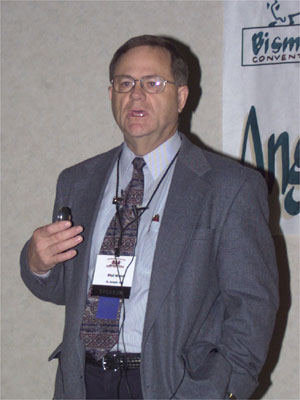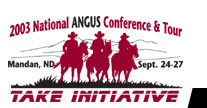|
|

“Take care to process and protect them properly”
Philip W. Widel, DVM, Technical Services Veterinarian
Boehringer Ingelheim Vetmedica, Inc.
Click here to view the presentation (in PowerPoint format).
Click here to listen the presentation.
You will need Windows Media Player to listen in.
Click here to download a free version.
Take Care to Process and Protect Them Properly
A cattle producer’s health program should be to process and protect. “Our goals should be to process in a manner to minimize tissue (carcass) damage while providing maximum protection from the products we use,” explained Philip Widel DVM, during his presentation at the 2003 National Angus Conference, September 25, 2003, in Mandan, N.D. Widel is a technical services veterinarian for Boehringer Ingelheim Vetmedica, Inc. (BI).
“To understand protection is to understand immunity to disease,” Widel explained. “Immunity is the ability to protect against specific diseases by producing antibodies and cellular immunity against those disease organisms.”
Vaccination is the application of a vaccine and immunization is the process of making immune. According to Widel, immunization can be achieved by:
• Natural exposure (disease occurrence)
• Vaccination with biological product
• Transfer of passive immunity in colostrum or antiserum (temporary)
When vaccinating, producers can chose between modified live (MLV) and killed vaccines. Killed vaccines include killed or inactivated viruses, bacterins and toxoids. According to Widel, the advantages of killed virus vaccines are that they are safe in pregnant animals and are labeled for use in calves nursing pregnant cows. There is no mixing with a killed vaccine, and it is very stable. The disadvantages of killed vaccines are that they require a booster; they can cause injection site reactions and there is a slower immune system response, Widel added.
MLV vaccines, according to Widel, provide rapid, longer-lasting protection; stimulate antibody and cell-mediated immunity; stimulate interferon production; stimulate immune response more similar to natural infection; and they are less expensive and are less likely to irritate cattle.
“With MLV vaccines, one dose starts initial immune system stimulation,” Widel explained. “Organism continues to grow or replicate so that stimulation of the immune system is continued until a level of immunity is created that can overwhelm and destroy the organism.”
The disadvantages of an MLV vaccine is handling considerations — UV light exposure, temperature, mixing, storage and label precautions with pregnancy.
“A successful immunization requires a health susceptible animal; proper administration; and safe, viable and potent vaccine,” Widel said.
Listen to the audio of Widel's presentation while paging through his PowerPoint to learn more about immunization practices.
— by Angie Stump Denton
 |
| For highest immunity, vaccinate prior to the time a herd may be exposed to a challenge, which could be the introduction of replacement heifers or bringing in a new sire at breeding time. Phil Widel, DVM, said, "The purpose of vaccinating is for individual protection, herd immunity and bio-security; to reduce reproductive losses; improve performance; and for marketing program participation." Widel has been with Boehringer Ingelheim Vetmedica, Inc. (BI), for more than 20 years. BI is the major sponsor of the National Angus Conference & Tour. |
|



|




